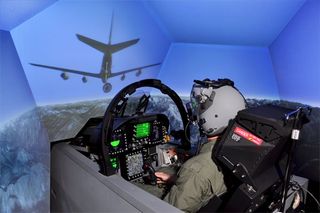VESA Releases Version 2.0 Of Its MPCDI Standard For Multi-Unit Projectors
The Video Electronics Standards Association (VESA) has just released version 2.0 of its Multiple Projection Common Data Interchange (MPCDI) standard. The new specification allows the projectors in multi-unit installations to share calibration settings, picture modifications and alignment specs by using a common data format. This makes it easier for technicians to create super large images without color-blending artifacts or distortion.
When we think of front projection, we imagine a single projector throwing an image onto a flat screen. But in large commercial applications there are often multiple units and multiple screens, some of which may not be flat or even perpendicular to the lens axis.

In these situations, two or more projectors must be precisely aligned, both mechanically and digitally to either create a single brighter picture or one that is edge-blended into a larger image than is possible with one display. Matching color, especially with DLP models, is the most difficult aspect of this alignment.
With version 2.0 of the MPCDI Standard, technicians now have three new additions to their toolbox -- color definitions, color XML specifications and revised extension examples.
Color definitions are full 3D lookup tables, which are stored for the use of all projectors in the chain. Color mapping is supported, which allows different displays to be precisely color-matched and blended. It is no longer necessary to have identical display units to ensure quality.
Color XML headers have been modified to allow different displays to all speak the same language and share the data necessary for correct alignment.
Revised extensions, formerly a series of .png files, are now covered in the standard directly. The lookup tables can correct image distortion and chromatic aberration introduced by the projectors' optics. They can also store warp data for each color channel separately.
Stay On the Cutting Edge: Get the Tom's Hardware Newsletter
Join the experts who read Tom's Hardware for the inside track on enthusiast PC tech news — and have for over 25 years. We'll send breaking news and in-depth reviews of CPUs, GPUs, AI, maker hardware and more straight to your inbox.

One of the most famous examples of multi-projection is in large commercial and military flight simulators. The most sophisticated systems use large-format projection on screens outside the simulators' windows rather than in-cockpit LCD panels. To properly stitch many images together it's necessary for each projector to be precisely calibrated and edge-blended. Furthermore, the screens must be curved or at least angled to provide a realistic sense of immersion for the simulator operator. This requires warping of the image to best mimic the pilot's peripheral vision.
With VESA's new MPCDI standard, calibration and image modification can be carried out just once. Then the data can be shared by all displays in the system.

Where are you most likely to see the benefits of this new standard? Next time you visit your local theme park, ask yourself how that five-story tall image of Optimus Prime in the Transformers ride got there. Most likely it's the result of several large projectors working together to create a lifelike image that you'll swear is about to walk off the screen!
Follow us @tomshardware, on Facebook and on Google+.

Christian Eberle is a Contributing Editor for Tom's Hardware US. He's a veteran reviewer of A/V equipment, specializing in monitors. Christian began his obsession with tech when he built his first PC in 1991, a 286 running DOS 3.0 at a blazing 12MHz. In 2006, he undertook training from the Imaging Science Foundation in video calibration and testing and thus started a passion for precise imaging that persists to this day. He is also a professional musician with a degree from the New England Conservatory as a classical bassoonist which he used to good effect as a performer with the West Point Army Band from 1987 to 2013. He enjoys watching movies and listening to high-end audio in his custom-built home theater and can be seen riding trails near his home on a race-ready ICE VTX recumbent trike. Christian enjoys the endless summer in Florida where he lives with his wife and Chihuahua and plays with orchestras around the state.
Most Popular




